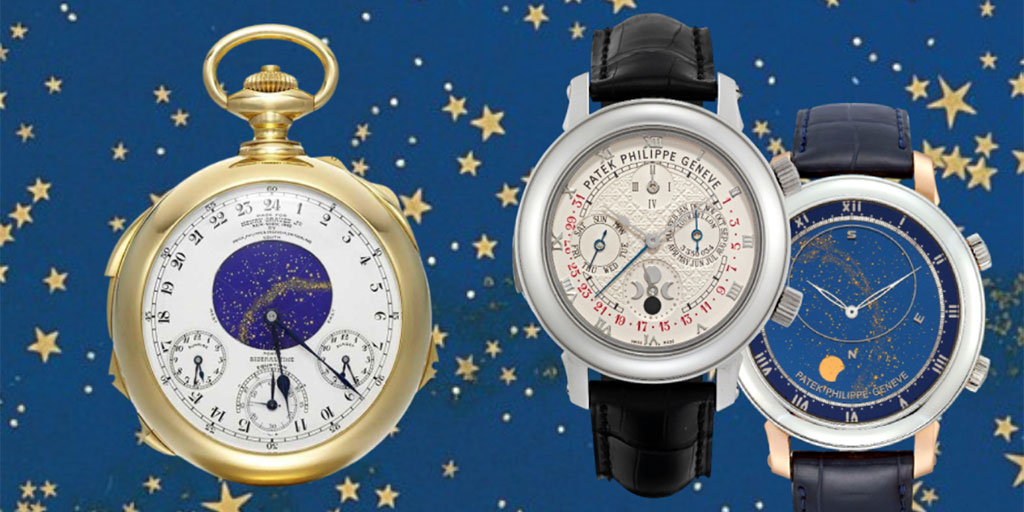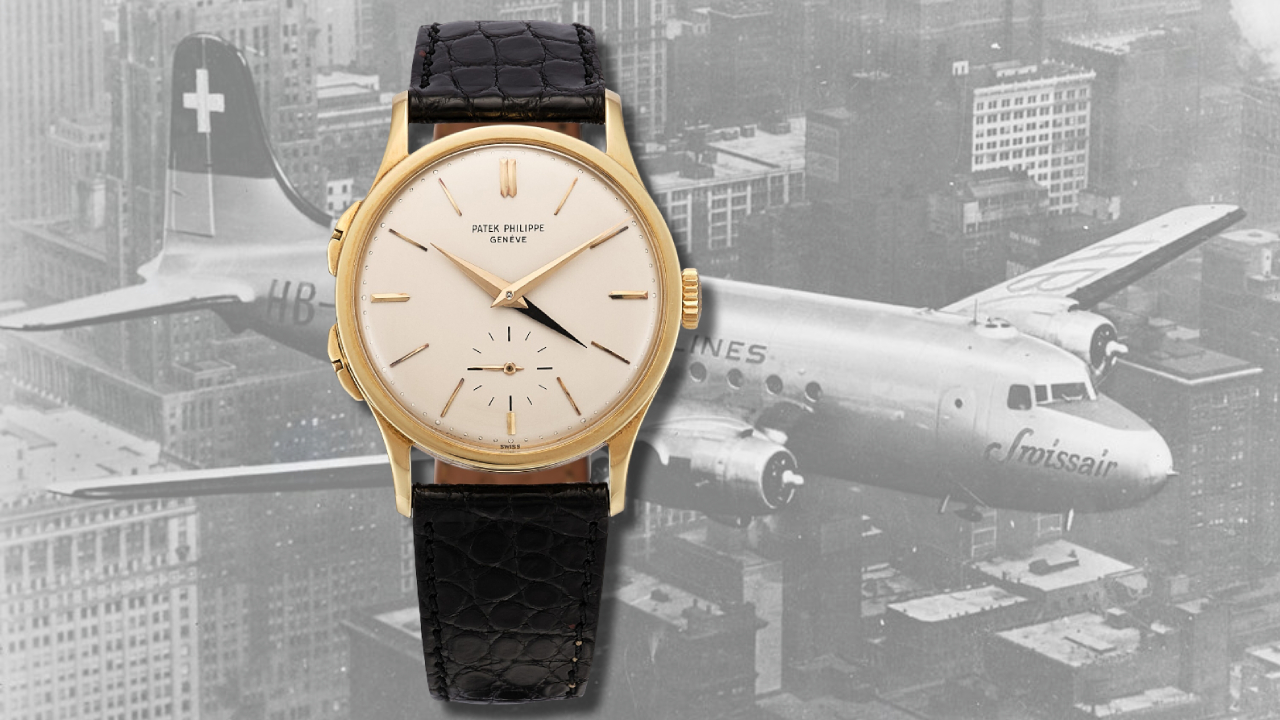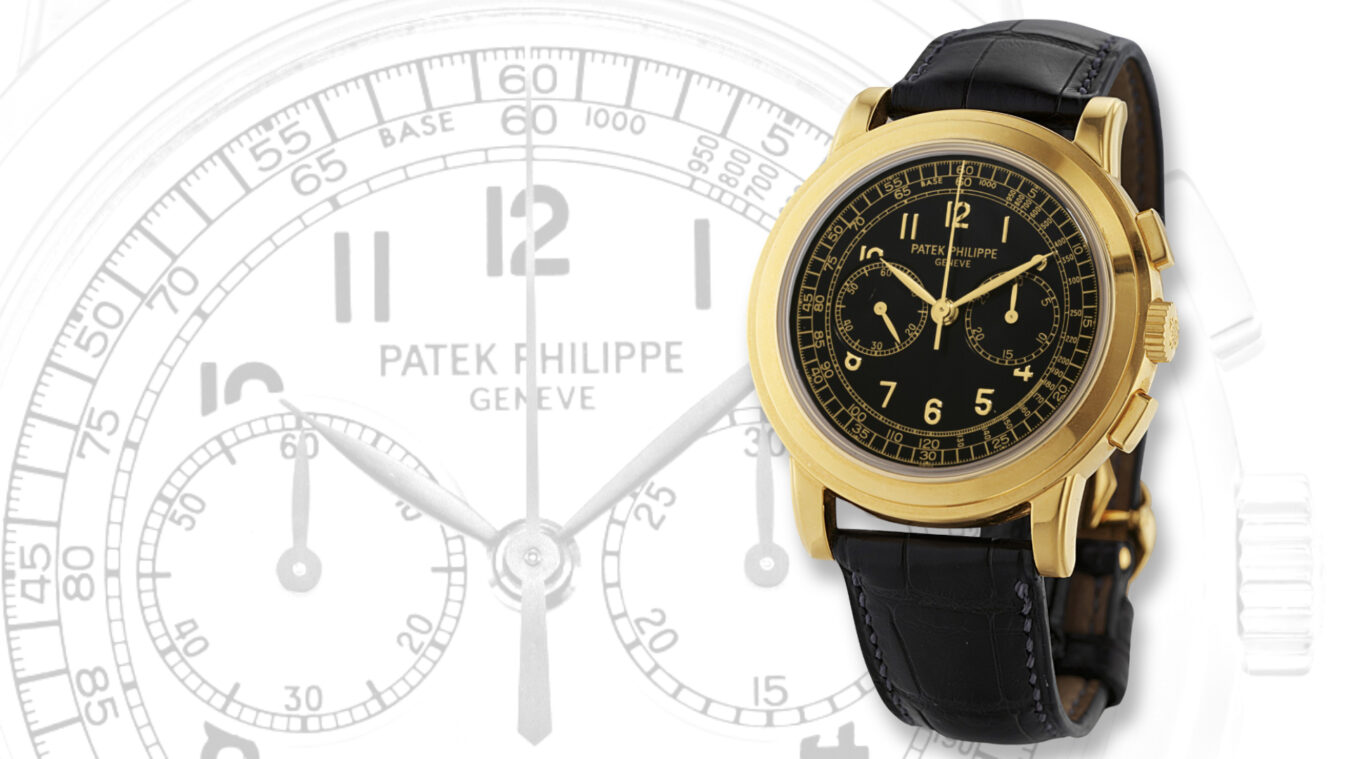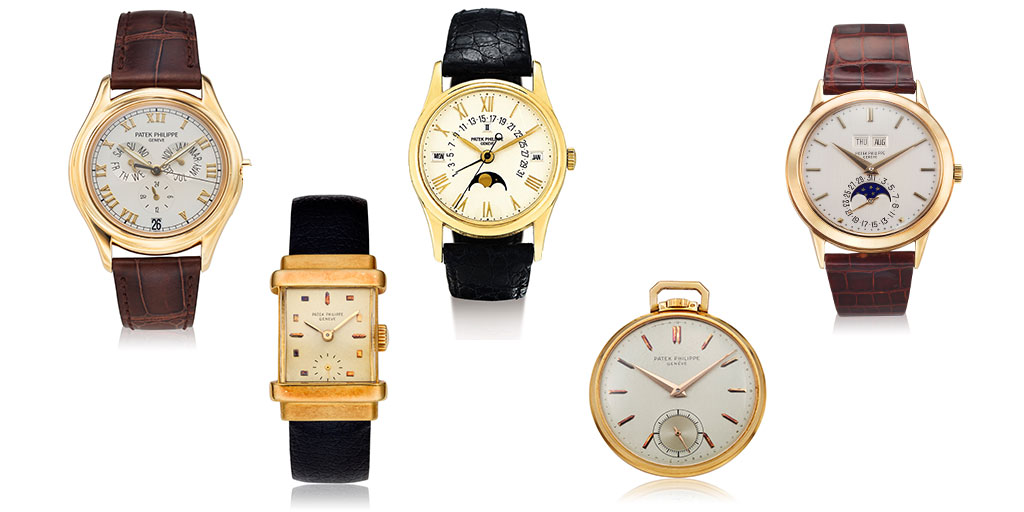Since the dawn of civilization, humanity has gazed upward in wonder, charting the heavens to navigate oceans, mark seasons, and seek meaning in the cosmos. The celestial chart in horology represents this ancient aspiration translated into mechanical poetry—not merely observing the stars, but capturing their eternal dance on the wrist.
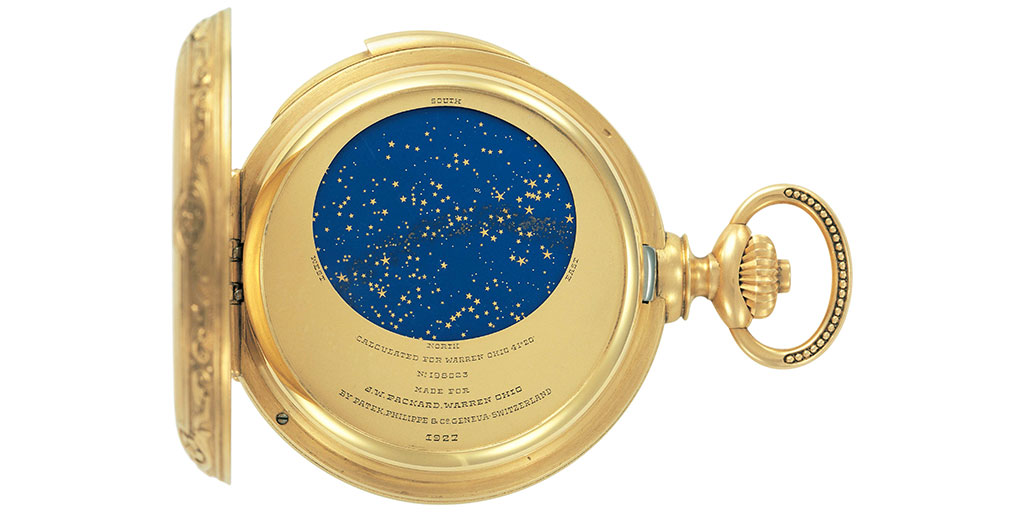
When Patek Philippe introduced its first watches with sky charts in the 1920s, these weren’t just technical achievements. James Ward Packard commissioned a pocket watch displaying the night sky over his hometown of Warren, Ohio. Henri Graves Jr. requested the view from his Manhattan apartment. These deeply personal instruments transformed watchmaking into something transcendent: a connection between individual legacy and cosmic permanence.
After decades focused on relatively simpler complications, Patek Philippe returned dramatically to celestial horology in 1989 with the Caliber 89—the most complicated watch ever made at the time. This bold statement amid the quartz crisis reaffirmed mechanical supremacy and reignited the manufacture’s commitment to astronomical complications. The new millennium brought a celestial renaissance: the Star Caliber 2000, the spectacular Sky Moon Tourbillon (ref. 5002), and the elegant Celestial (ref. 5102), each pushing technical and artistic boundaries while remaining among the rarest watches ever produced.
This article traces the evolution of Patek Philippe’s celestial watches from their origins to today’s masterpieces, exploring their groundbreaking innovations, exquisite artistry, collectability, market significance, and the special orders that make each piece extraordinary.
One Hundred Years Ago: The Very First Patek Philippe Watches with Celestial Charts
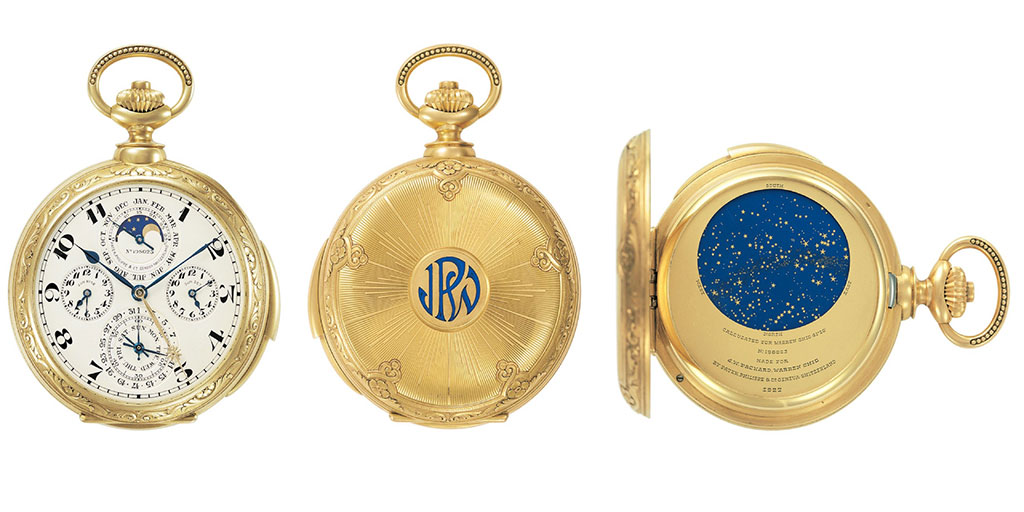
The history of celestial watches at Patek Philippe is inseparable from an American industrialist and an American banker who were great patrons of the firm back in the 1920s and the subsequent Great Depression.

James Ward Packard: Pioneer and Patron
James Ward Packard was born on November 5, 1863, into a family of businessmen in Warren, Ohio. From a young age, he had a curious and ingenious approach to the world around him, working on cutting-edge technologies and eventually earning 40 patents. At 27, he and his brother William founded the Packard Electric Company in 1890. Light bulbs and electrical energy were still relatively new—Edison had only patented them in 1880—and the establishment of electric lighting and power networks promised to be highly lucrative. Electricity represented a transformative force that promised revolutionary change, though the infrastructure and applications had yet to be developed. Cars were also a very new technology. According to legend, Packard purchased a car that broke down so often on the 65 miles between Cleveland and Warren that it took 11 hours to complete the journey. This frustration led him to build his own cars, with the first Packard Model A delivered in November 1899. The company became America’s leading luxury carmaker, and James Ward Packard was inducted into the Automotive Hall of Fame in 1999—the single greatest honor in the motor vehicle industry.

Watches were one of his great passions. He started commissioning watches from Patek Philippe in 1900 and challenged the Geneva-based company to create ever more sophisticated pieces, ordering a total of 13 pieces during his collecting journey. In particular in 1916 he took delivery of the most complicated watch Patek Philippe had ever produced (No. 174,129) with 16 complications, including perpetual calendar, split seconds, grande and petite sonnerie and minute repeater.
Two watches with unmistakable sentimental value will be remembered most by enthusiasts. Pocket watch No. 198,014 delivered in 1927 featured a musical alarm (a very unusual feature) with an ingenious design that allows the alarm to play the entire melody of his mother’s favorite tune, Godard’s “Jocelyn Lullaby”. That same year, he acquired his most famous Patek Philippe, a double-faced pocket watch with 10 complications known as “The Packard” (No. 198,023). This astronomical pocket watch was fitted with a case back that opened to reveal a rotating celestial map. More than 500 stars in six different sizes, enameled in gold, depicted a night sky, but not any night sky – it showed the sky as it would appear over Packard’s hometown of Warren, Ohio. This was the very first watch made by Patek Philippe displaying a sky chart. Packard received the watch while already being treated at the Cleveland Clinic for a brain tumor. He would pass away in 1928 and will be forever remembered as one of the most important Patek Philippe patrons of all time. The Packard is now part of the Patek Philippe collection and on public display at its’ Museum in Geneva.
Henry Graves Jr.: The Ultimate Collector
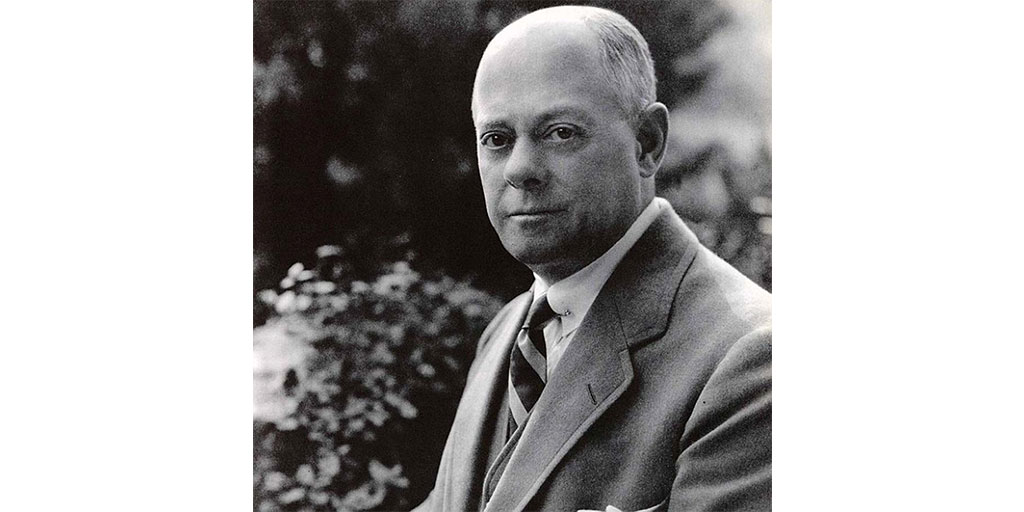
The other great patron of Patek Philippe of the same era was Henri Graves Jr. He made his fortune through banking, railroads, and real estate investments, inheriting substantial wealth from his father, who was a founder and partner in the Maxwell & Graves banking firm. Graves Jr. expanded his family legacy by generating millions of dollars through these financial and infrastructure enterprises during the late 19th and early 20th century. He was recognized as a member of America’s old-money aristocracy and also used his resources to pursue various collections: watches, rare coins, Chinese porcelain, Old Master artworks and more.

While legend has it that both Packard and Graves were competing to commission the most complicated watch, there is very little evidence to actually support this. Both came from very different social circles, they most likely never met and while Graves was aware of Packard’s previous commissions, Packard likely was not aware of Graves pieces.
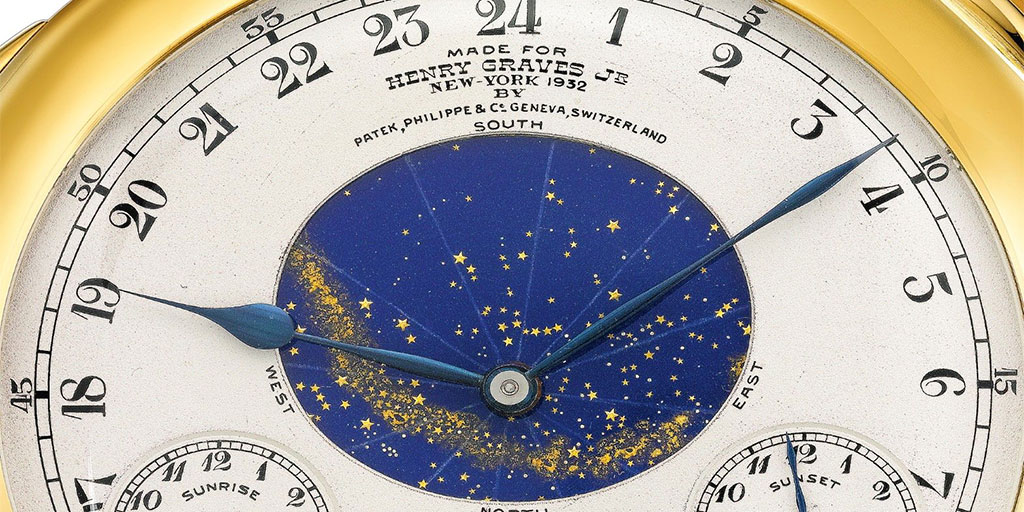
Henri Graves Jr. ordered about 30 watches from Patek Philippe during his collecting journey, among which were many special commissions. The apotheosis of his watch collection is undoubtedly the now legendary “Supercomplication” (No. 198,385). Commissioned in 1925 and delivered in 1933, it features 24 horological complications and was crafted entirely by hand, obviously without the aid of computers. Weighing 1.3 pounds and containing 920 individual parts, it features a Westminster chime minute repeater, a perpetual calendar, a split-seconds chronograph, equation of time and a celestial map of the night sky.
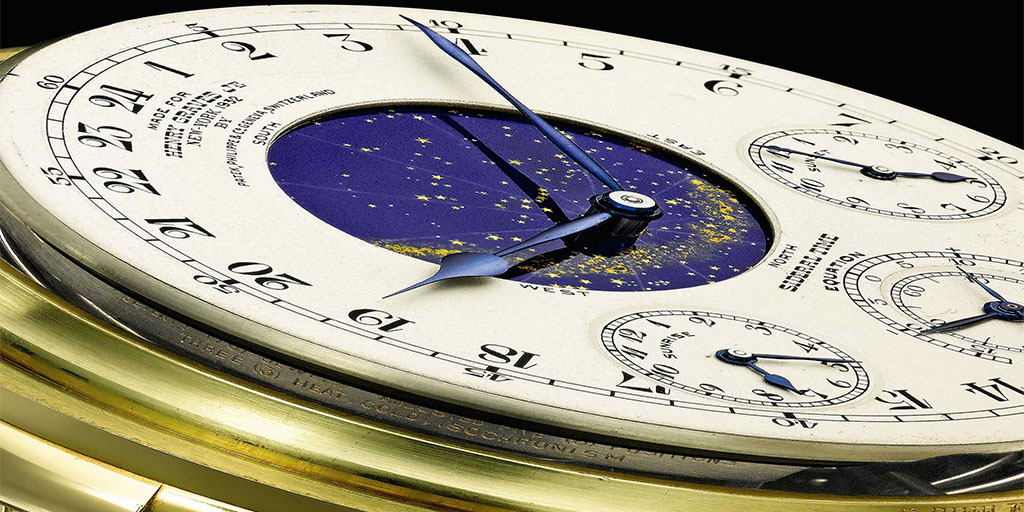
Here again the sentimental aspect is obvious as the sky chart depicts the view he would have had from his home in New York. Upon completion, it was the most complicated mechanical watch in the world, surpassing the French L. LeRoy 01 from 1904 (20 complications), and remained so for more than half a century. Graves paid 60,000 Swiss francs (about $15,000 in 1933) for the watch, an enormous amount of money, and it stayed with him until his death in 1958 at the age of 83. The Supercomplication sold publicly first in 1999 at Sotheby’s reaching $11 million and again in 2014 reaching $24 million, in both instances it was the most expensive price ever paid for a watch at the time. It now resides in a private collection.
An Unsolved Mystery
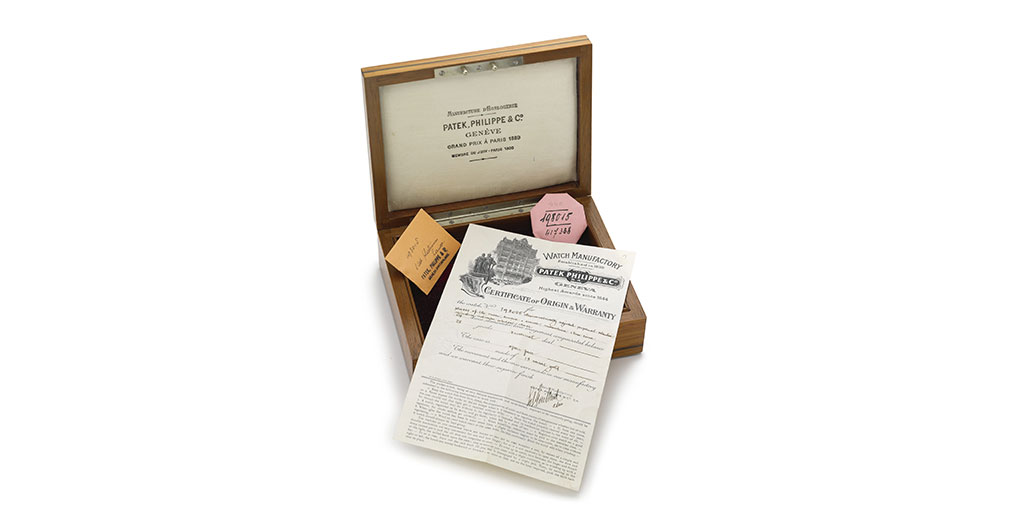
However, the story may not end here. Evidence supports the possible existence of a second pocket watch with a sky chart commissioned by Henri Graves Jr. (No. 198,025). Indeed, Sotheby’s publicly sold a wooden box made for Henri Graves Jr. in 2012 and its accompanying Certificate of Origin describing a watch with “chronometrically adjusted perpetual calendar, phases of the moon, sunrise, sunset, mean time, true time, winding indicator, and celestial chart”.
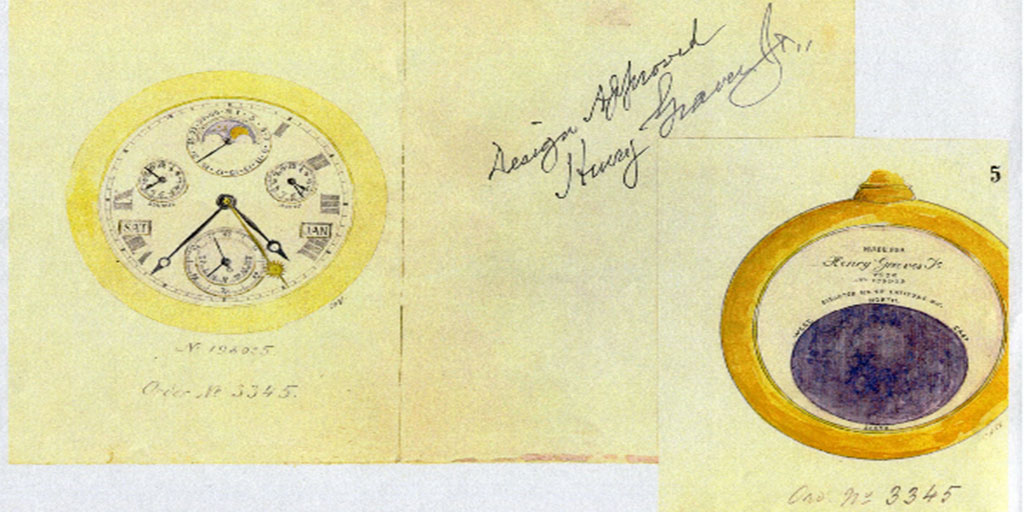
The watch reference refers to the 1920s and it could possibly have been delivered around the same time as the Packard. As the whereabouts of this watch remain unknown, please reach out if you can provide any information to locate the watch and help solve one of Patek Philippe’s greatest mysteries – this would be a great honor.
Modern Celestial Pocket Watches
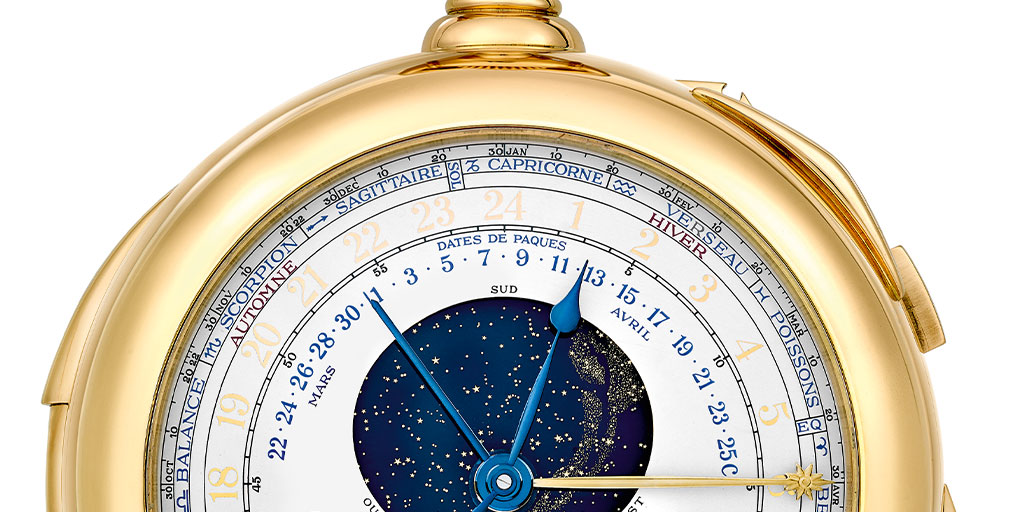
The Caliber 89: A History-Defining Timepiece
Producing and selling these very complicated timepieces helped Patek Philippe in the challenging 1930s but didn’t prevent the firm from running into financial turmoil. This was when Charles and Jean Stern acquired the Manufacture in 1932 and refocused the company, particularly on wristwatches, which were starting to replace pocket watches at the time.
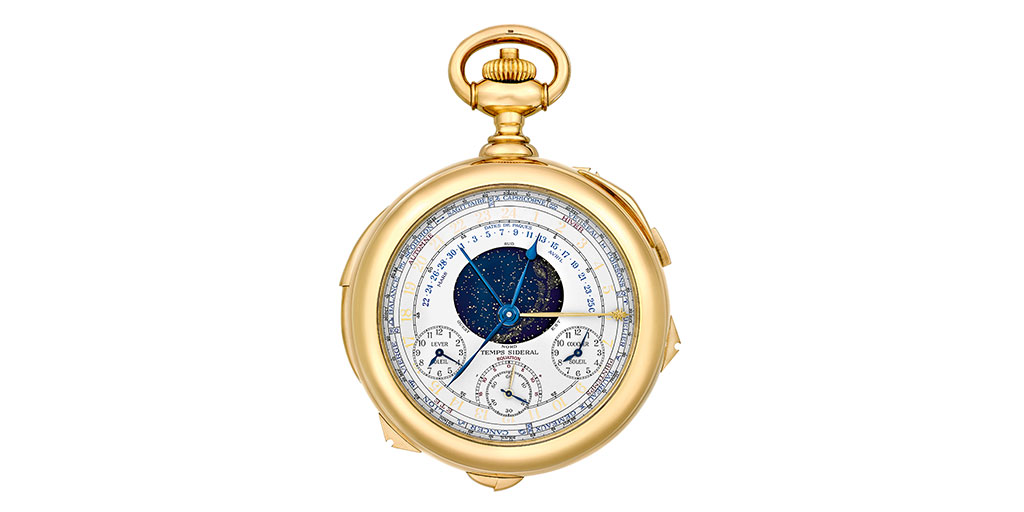
This continued until the early 1980s and the approach of Patek Philippe’s 150th anniversary in 1989. Swiss watchmaking was facing the challenges of the quartz revolution and Patek Philippe’s management decided to embark on a risky journey: beating its own record by surpassing its most complicated mechanical watch from 1933. Over the course of nine years, a team composed of both engineers and watchmakers took on the challenge and created Caliber 89 with 33 complications. This was one of the first watches designed with the assistance of a computer – a cutting-edge technology at the time, though the computing power was remarkably modest by today’s standards. This pocket watch contains 1,728 components, weighs 1.1 kg, and features 24 hands. The complications include functions such as a grand sonnerie, minute repeater, split seconds chronograph, perpetual calendar, thermometer, barometer, altimeter, compass and obviously a celestial chart depicting the sky over the city of Geneva.
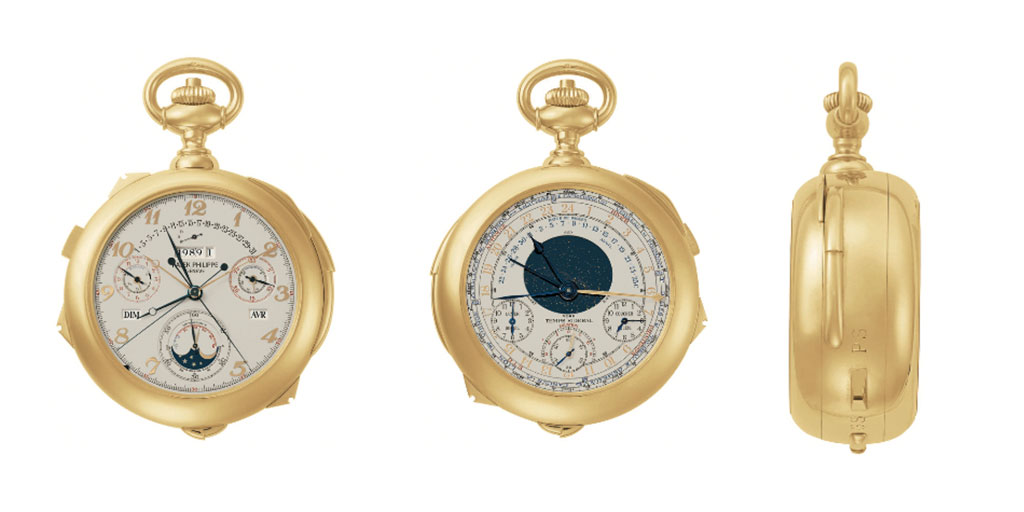
Only four unique Caliber 89 pieces were made—one in each metal: yellow, rose, white gold and platinum. The yellow gold was sold at the now legendary “The Art of Patek Philippe” auction on April 9, 1989 for CHF 4.95 million ($3.2 million), an enormous sum and the record for the most expensive watch sold back then.
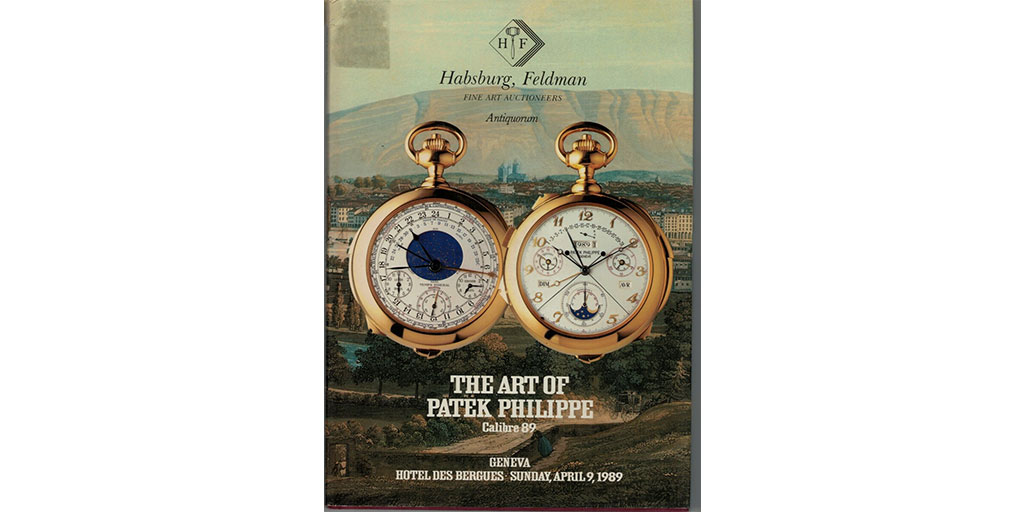
While the white gold model was sold by Antiquorum in 2004 for CHF 6.6 million, the rose gold and platinum models have never been offered publicly and all four pieces are in private collections. The Patek Philippe Museum displays a prototype with no movement inside.
Celebrating the New Millennium with Star Caliber 2000
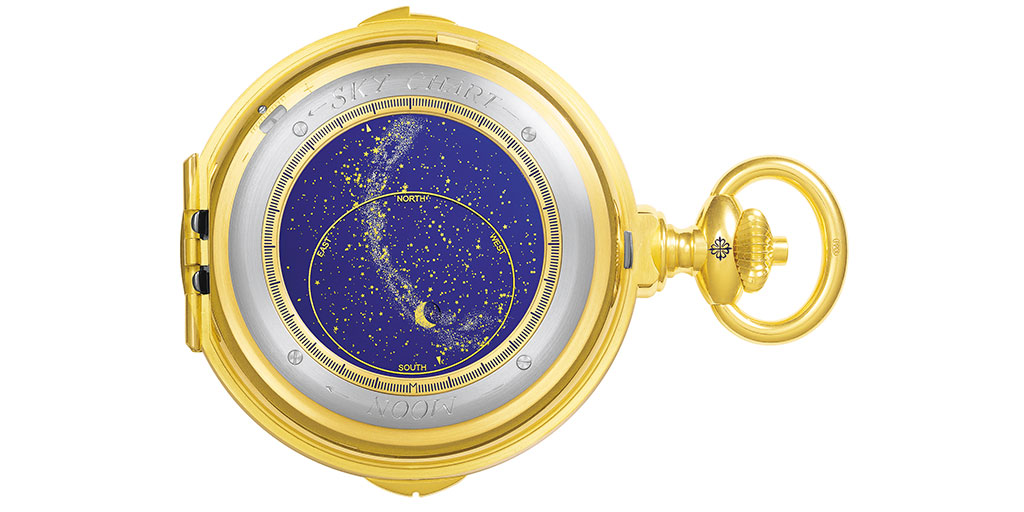
As anyone born in the 20th century and old enough to remember the switch to the new millennium will attest, it was a moment of great excitement, the year 2000 had been a symbol of the future for many decades and the turn of the millennium was a highly significant cultural event worldwide. It thus comes as no surprise that Patek Philippe had secretly worked on something very special to mark the occasion.
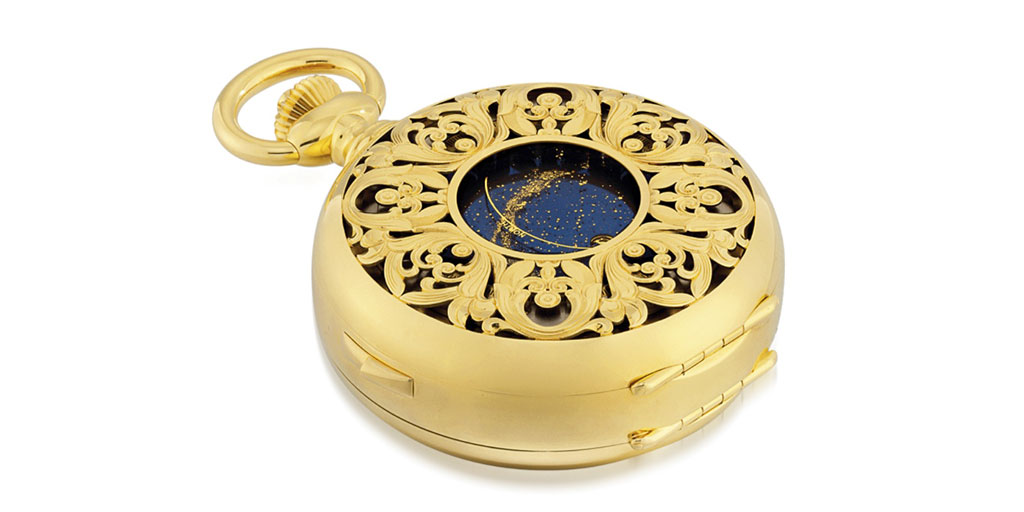
Conceived as early as January 1993 and presented on October 5, 2000, it took dozens of expert watchmakers and engineers working together to produce Star Caliber 2000, the masterpiece which features 21 complications and a staggering 1,118 components, introducing 6 new patents and ranking it as one of the most complicated watches in the world. The Westminster Chime perfectly replicates the sound of London’s Big Ben clock with five hammers striking five gongs. The celestial side portrays a mobile sky chart, based on the view of the nocturnal sky as seen from Geneva, Switzerland, with the visible portion for any given day and time highlighted by a rotating golden ellipse frame.
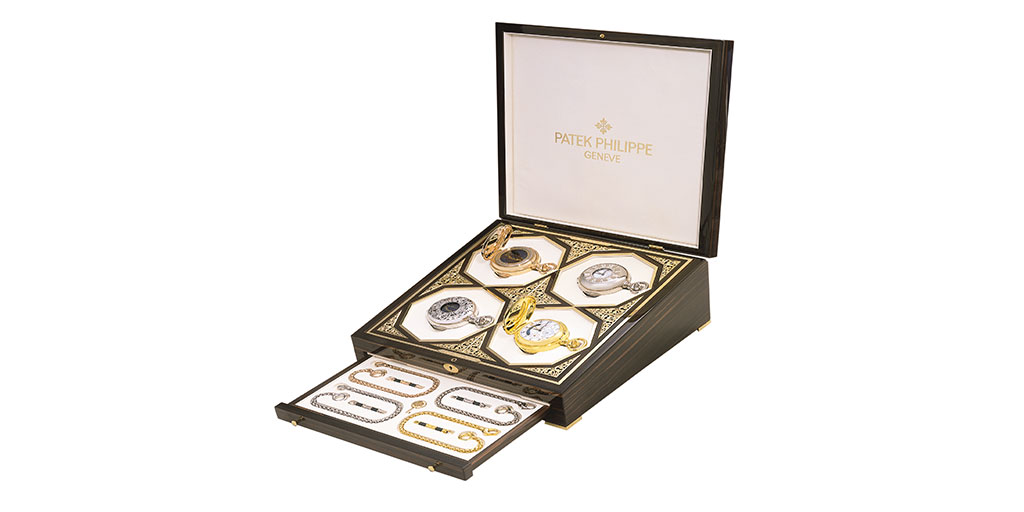
Only twenty of the Star Caliber 2000 watches were made in total, grouped into five sets of four watches each. Four sets consisted of yellow, white, rose gold, and platinum watches with identical engravings, while the fifth set was made entirely in platinum with distinct engraved motifs on each watch. The original cost for one set was around 13.2 million Swiss francs (about $7.5 million USD in 2000). So far only one yellow gold example has been sold publicly for $3.3 million at Christie’s in 2012, meaning at least one of the sets was split up. Sotheby’s will for the first time auction a complete set in Abu Dhabi in December 2025. Another full set resides in the Patek Philippe Museum.
Celestial Chart Wristwatches
Developed simultaneously with the Star Caliber 2000, two wristwatches would mark history by being Patek Philippe’s first wristwatches with a celestial chart display. In 2001, Patek Philippe introduced the double-faced ref. 5002 Sky Moon Tourbillon and in 2002, its sibling ref. 5102 Celestial.
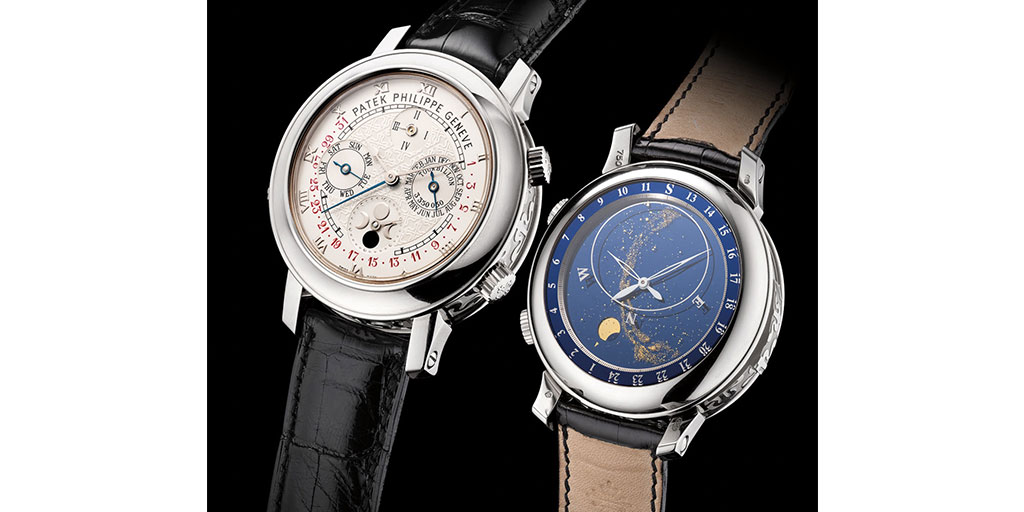
The Sky Moon Tourbillon Ref. 5002
The Sky Moon Tourbillon was a revolution at the time as it was the most complicated wristwatch ever made. It featured 12 complications, in particular combining four of the most special functions: a minute repeater, a retrograde perpetual calendar, a Tourbillon hidden from view, and on the back a celestial chart indication depicting the in the northern hemisphere.
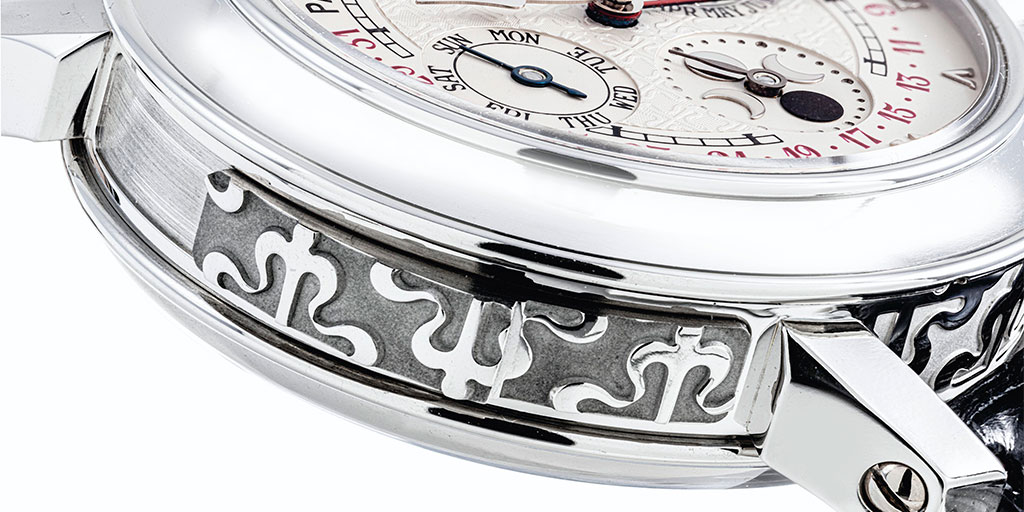
On the wrist the watch has an unmistakable and commanding presence. The 42.8mm diameter and 16.3mm height impart a feeling of weight and solidity, gravitas and elegance that is rare even among complicated watches.
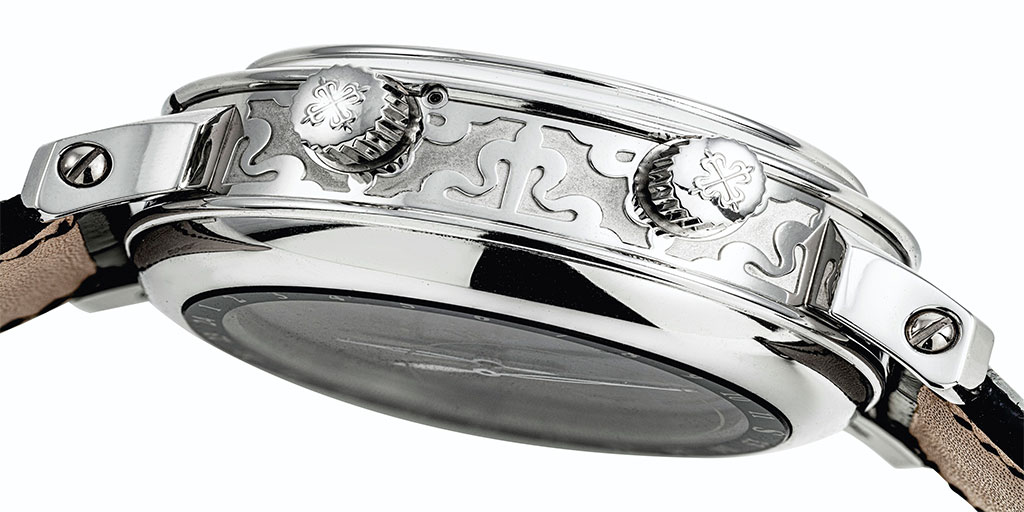
Each face of the watch has its own set of indications. On the front are the calendar indications—day, month, leap year, and moon age—with the retrograde date shown on the outer scale in red. The hands indicating the date are all blued, while the other hands are silver. The inside part of the dial – with the exception of the counters – is covered with a Calatrava-cross pattern, which has been achieved through complex, hand-guilloché work. As with most tourbillons from Patek Philippe, only the movement number is visible on the dial, here in the 3 o’clock counter.
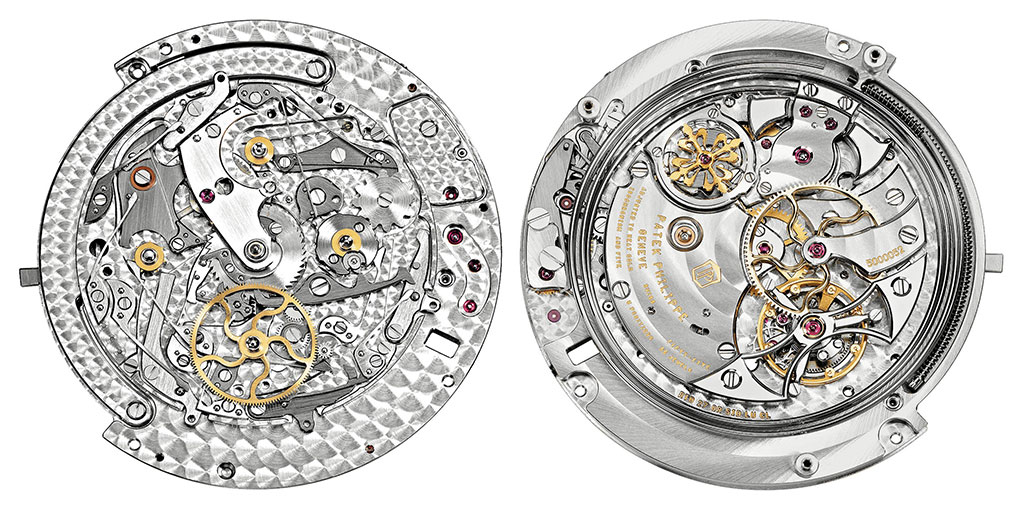
On the back, the beautiful sky chart takes over the entire space. It is achieved using a rotating blue disc with an aperture for the age of the moon phase, topped by a transparent sapphire disc bearing the night sky’s stars. An elliptical contour outlines the visible night sky as seen by an observer from Geneva.
The case reflects Patek Philippe’s traditional savoir faire. The upper bezel is concave with inner and outer flanges creating fluidity, while the bezel on the back is domed and visually complements the front but without an inner flange, replaced with a 24-hour scale around the celestial dial. The lugs are stepped, and the strap is fixed via visible screws and bars rather than spring bars, ensuring extra solidity. The case flanks are decorated with raised, highly polished, repeating half Calatrava Cross motifs, which stand out on a matt ground. The minute repeater slide is recessed within the case band and decorated with the same Calatrava Cross motif creating a perfect continuity. Anecdotally, the platinum models do not feature the usual diamond on the case band at 6 as it would have clashed with the Calatrava motif.
The combination of complications was achieved with a modular construction of the movement, which bears the designation R TO 27 QR SID LU CL, made up of 694 parts. Here is the breakdown of the functions of the movement:
- Base caliber: manual-wound repeater tourbillon caliber R TO 27 was initially introduced in 1993 on the ref. 3939. The minute repeater is remarkable for its “cathedral gongs”, two extra-long gongs assure the richness and clarity of the sounds. The tiny tourbillon is an exercise in miniaturization and precision as it is composed of no less than 69 individual parts, yet it weighs a scant 0.3 grams
- Front module: retrograde perpetual calendar
- Back module: celestial map with moon and sidereal time
The early movements all bear the Geneva seal, while the later ones bear the Patek Philippe seal (from ca. 2010 and movement numbers in the 4 and 5 million ranges). The former additionally came with a COSC certificate, while the latter came with a Patek Philippe rate accuracy certificate.
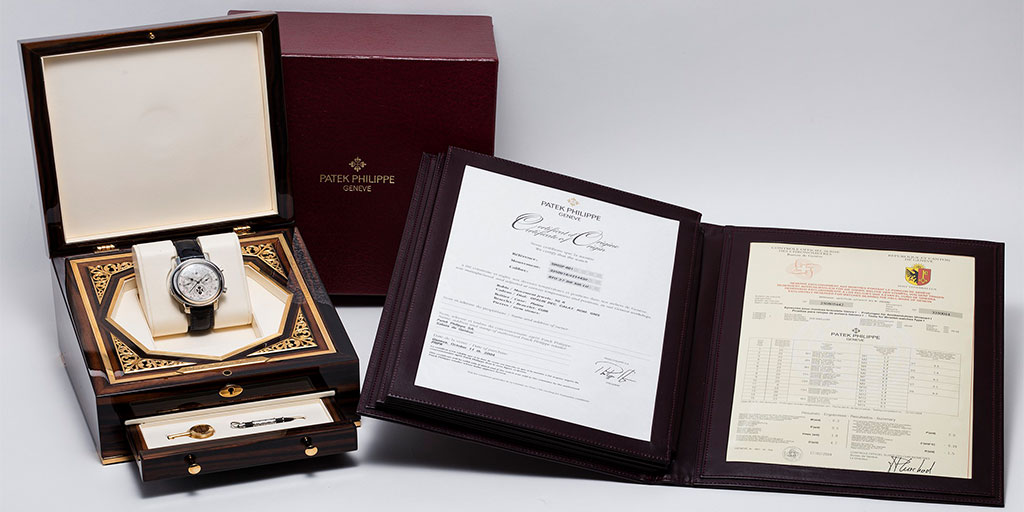
The full set is a work of art in and of itself. The lacquered box is made of Macassar-ebony wood with an inlayed central gold Calatrava Cross. The metal frames inside the box are not just gold colored, they are made of solid 18K gold and feature gold hallmarks. The drawer below contains a key to the box as well as the setting pin, which is decorated in the same precious metal as the watch case. Additionally, it comes with two leather binders: a large one holding the Certificate of Origin and original COSC/rate certificate, picture, and explanation of the functions, and a smaller one containing product literature. A full set obviously add to the collectability of the watch.
Collectability
The watch was made in all four precious metals: platinum, yellow, rose and white gold with a silver dial and red numerals for the retrograde date. While a production capacity of 2 per year was communicated (Patek Philippe magazine), it was increased over the years to reach up to an estimated 10 pieces per year, and the total production is estimated to be around 80-100 over 12 years, though Patek Philippe will not confirm these numbers. Based on appearance at auction, platinum and rose gold are the most common metals, while yellow and white gold are the rarest.
As of October 2025, the ref. 5002 has appeared 31 times (30 unique examples) at auction across Antiquorum, Christie’s, Phillips and Sotheby’s.
Excluding special orders and the model that was sold twice, the split by metal is the following:
- Platinum: 16
- Rose gold: 5
- White gold: 2
- Yellow gold: 1
Below is the price evolution of these sales. While the first examples sold for around $1.1 million, the sales since 2021 have all exceeded $1.5 million.
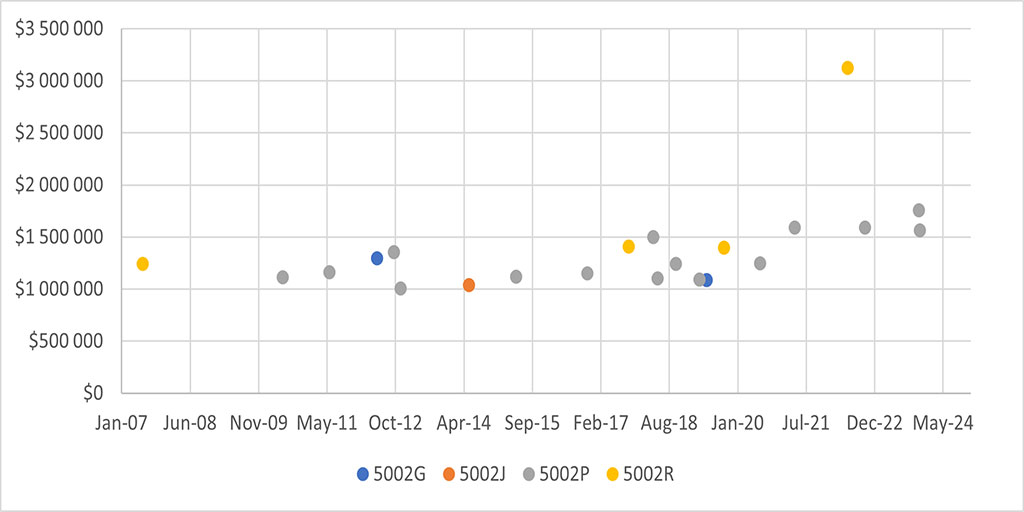
Special Orders
While the Sky Moon Tourbillon was an application model reserved for Patek Philippe’s most distinguished clients, some even had the honor of commissioning special-order versions. As Patek Philippe does not officially communicate on these pieces and clients often keep their creations private, it is quite possible more pieces exist.
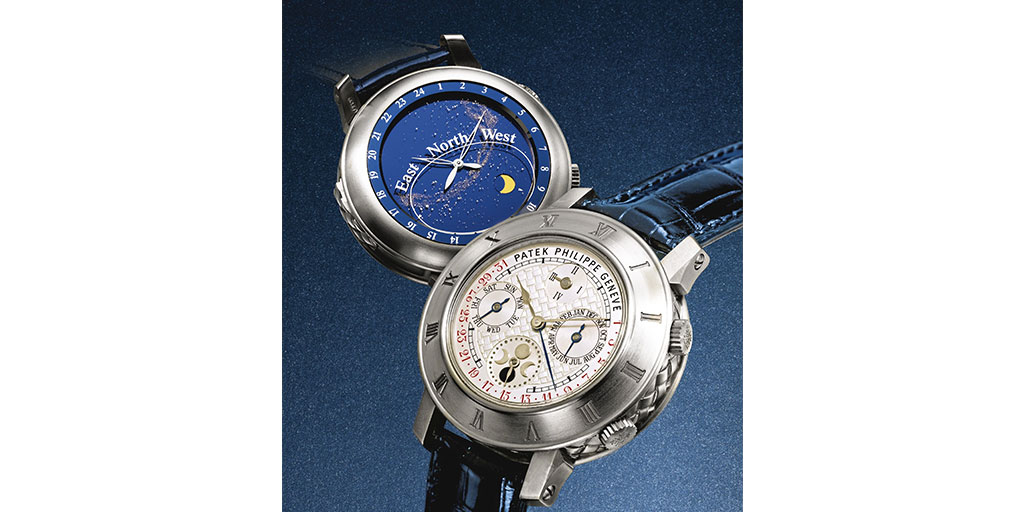
Ref. 5001T: unique case design and the only piece known in titanium
When Sotheby’s revealed they would offer the ref. 5001T at their June 2014 New York auction, it created quite a buzz. Not only was this Sky Moon Tourbillon launched in 2000 as per the date on the Certificate of Origin – this is one year prior to the launch of the ref. 5002 – it had a unique case design with a larger bezel with engraved Roman numerals and it was made in titanium. The case and dial are decorated with a ‘basket-weave’ (panier) pattern as opposed to the Calatrava Cross pattern. All of this led to the creation of a unique reference 5001. It was sold for $1.325 million, which was only marginally more than regular production ref. 5002s sold at that time, despite having so many unique features.
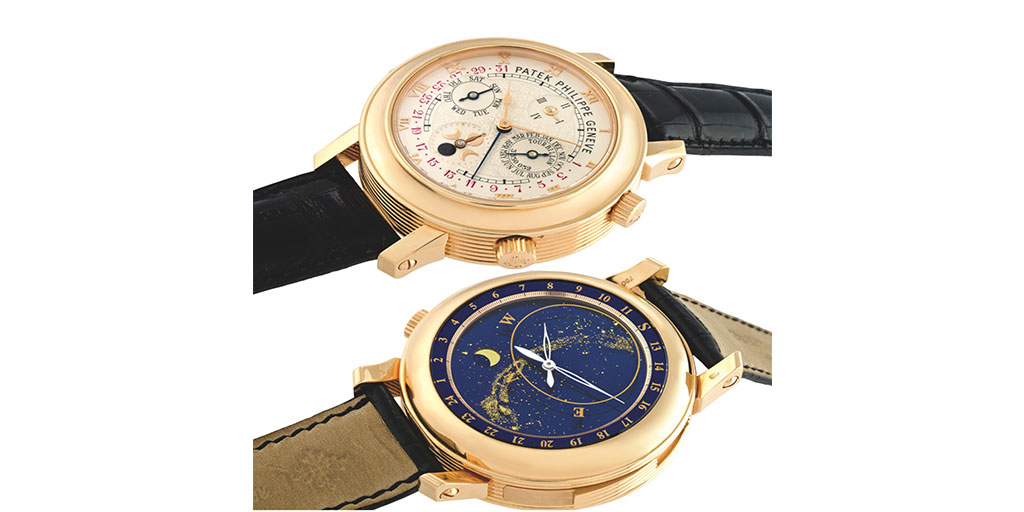
Ref. 5002R with ribbed case
Even for special orders, it is quite rare for Patek Philippe to change the case finishing. This rose gold example ref. 5002R made in 2008 featured a ribbed band composed of six concentric ribs, a unique decoration that replaces the Calatrava Cross motif and runs around the case and continues on the minute repeater slide. It was sold by Antiquorum in Geneva in May 2013 and reached $1.3 million.
The other known special orders feature black dials in different variations:
- Ref. 5002J-010: yellow gold, black dial – Sold for $1.2m by Patrizzi, New York, October 2009
- Ref. 5002R-014: rose gold, black dial with diamond indices – Sold for $4.1m by Christie’s, Hong Kong, May 2013 – holds the record for the most expensive ref. 5002 sold
- Ref. 5002G-010: white gold, black dial with red-painted numerals and white date – Sold for $2.3m, Phillips, Hong Kong, November 2019
- Ref. 5002P-013: platinum, black dial – Sealed auction with undisclosed price, Sotheby’s, Hong Kong, July 2023
The Ref. 6002 Sky Moon Tourbillon
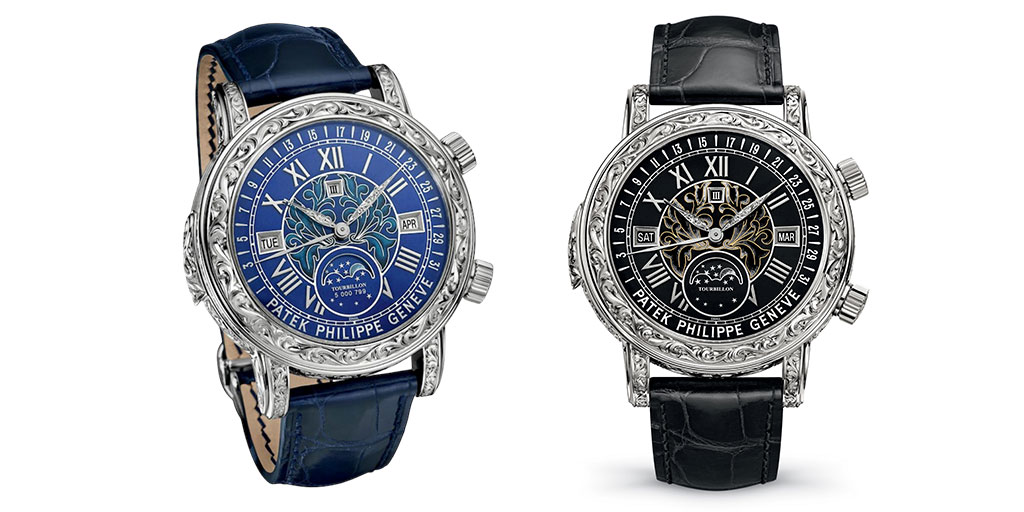
The successor to the ref. 5002 was introduced in 2013 with the ref. 6002. The current Sky Moon Tourbillon features the same functions as its predecessor. However, the perpetual calendar is displayed with discs, as opposed to hands, and the moon phase is shown on the front. The main difference lies in the 44mm case and dial, which have been embellished with rare handcrafts, an homage to the Genevan tradition and Patek Philippe’s commitment to perpetuating the century-old crafts.
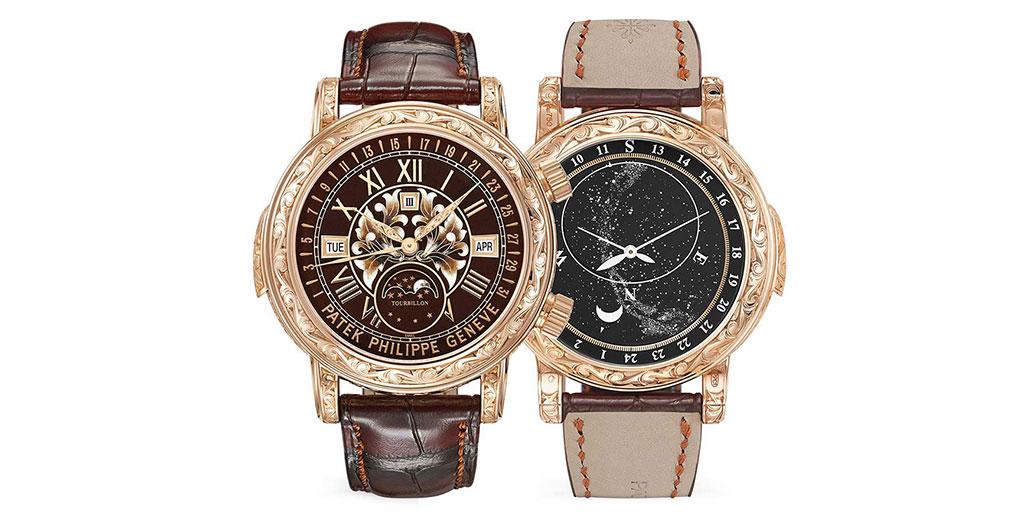
The case is a masterful work of art and is hand-engraved with intricate swirling arabesque ornaments. This engraving process is highly delicate and time-consuming, requiring over one hundred hours of artisan work to create the bas-relief decorations that both lift and sculpt the gold surface with three-dimensional details. The dial is made of Grand Feu enamel with a central arabesque motif that echoes the case, adding depth and richness to the watch’s aesthetic. The hour and minute hands have also been hand-engraved with a similar decoration.
To date, the ref. 6002 has been offered in three variations: white gold with blue enamel (2013-16), white gold with black enamel (2016-21), and rose gold with brown enamel (since 2021). They have not appeared at auction frequently enough to permit meaningful analysis.
The Single-Faced Ref. 5102 Celestial
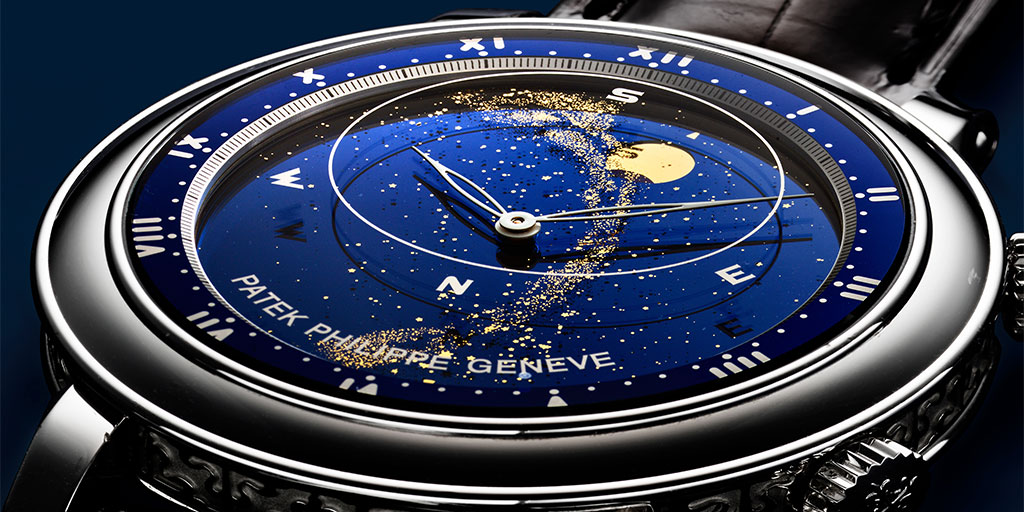
Along with the Star Caliber 2000 and the ref. 5002 Sky Moon Tourbillon, a simpler and certainly not less spectacular piece was launched in 2002: the ref. 5102, which for the first time displayed the unmistakable celestial chart as seen from the northern hemisphere and Geneva on the front of the watch giving it a whimsical aesthetic. The year of its launch, the watch won the “Aiguille d’Or”, the highest award at the Grand Prix de l’Horlogerie de Genève.
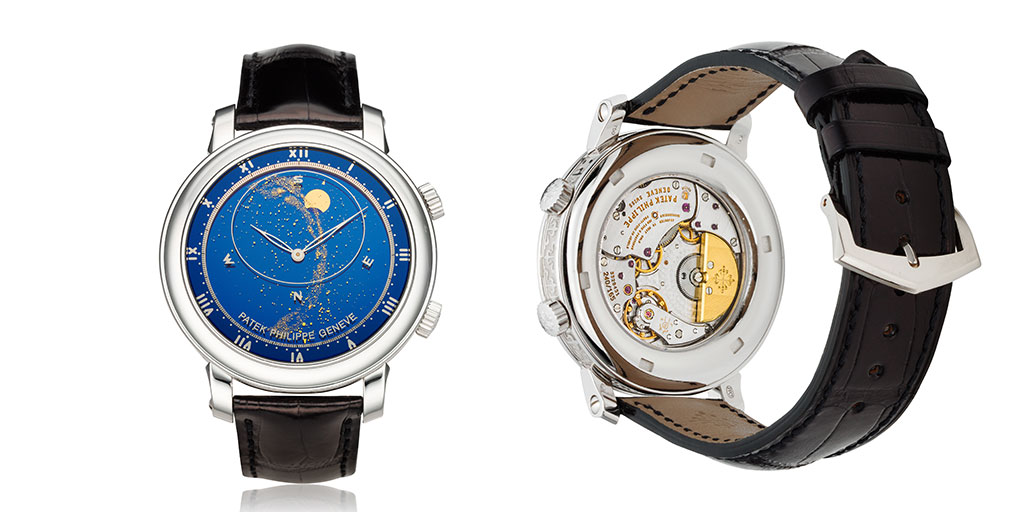
The deep blue dial shows the apparent movement of the stars, phases and orbit of the moon, and the time of meridian passage of Sirius and the moon. The sky chart is made of three superimposed, rotating sapphire discs creating real depth, while being surrounded by twelve Roman numerals.
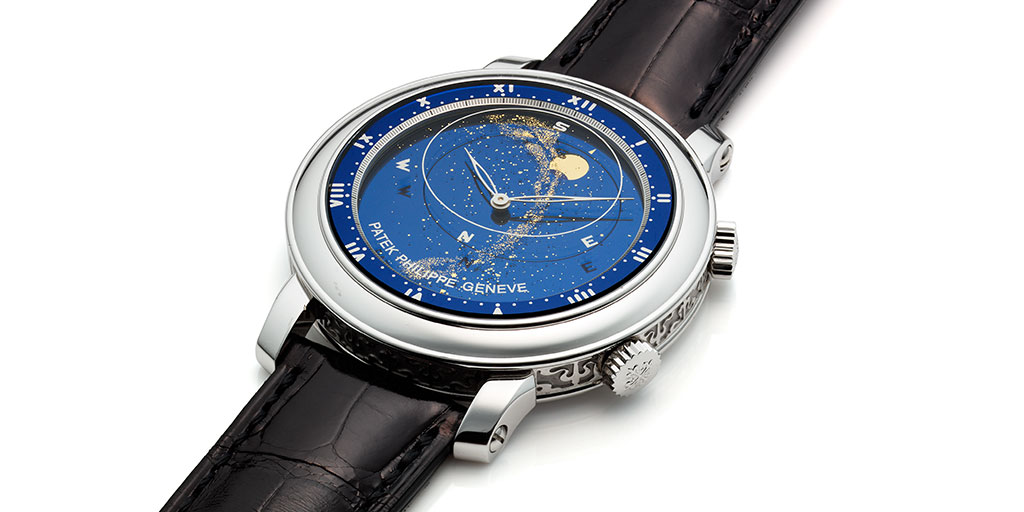
Similar to the ref. 5002, the 43mm case-band of ref. 5102 is engraved with repeating half Calatrava Cross motifs and the strap is also attached to the soldered lugs with a bar and screw as opposed to traditional spring bars. The two crowns are used to set the time and the celestial chart respectively. The sapphire case back gives full view of the movement. With a height of 9.8mm, the watch has a strong presence on the wrist but does not feel overwhelming, as the ref. 5002 could be for some.
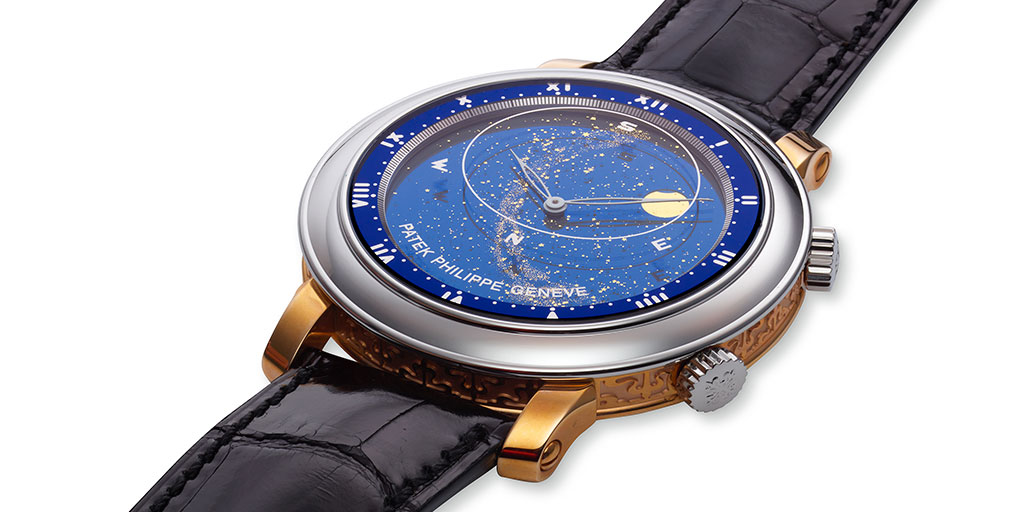
The movement (caliber 240 CL LU) is comprised of 301 components. At its base lies the automatic caliber 240 with its micro-rotor and the module for the sky chart has been added to the dial side. The early movements featured the Geneva Seal and were replaced by movements with the Patek Philippe Seal circa 2010 onwards and generally with movement numbers in the 5.5 million range.
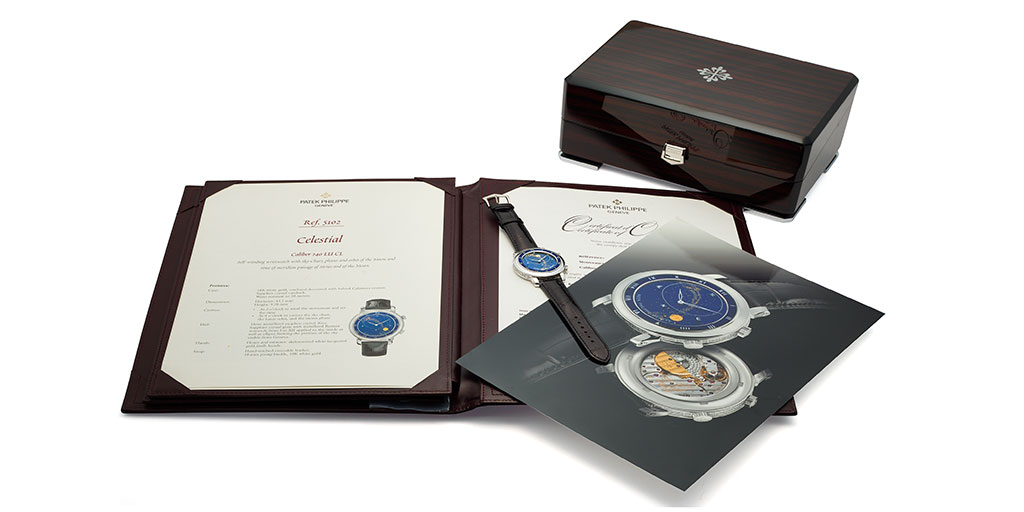
The full set is comprised of the wooden Patek Philippe box, a large leather portfolio with a picture and the Certificate of Origin, as well as a small leather portfolio with product literature.
Collectability
The ref. 5102 has been produced in three variations: white gold (ref. 5102G, 2002-07), yellow gold (ref. 5102J, 2007-09) and in two-tone with rose gold case-band and lugs and platinum bezel, crowns and back (ref. 5102PR, 2009-12, see above). While total production numbers are unknown, it certainly was only in the hundreds over its 10-year tenure given how difficult it was to be made.
As of October 2025, it has appeared 96 times (91 unique examples) at auction across Antiquorum, Christie’s, Phillips and Sotheby’s. Here is the breakdown by metal, excluding special orders and duplicate sales:
- White gold: 48
- Yellow gold: 20
- Platinum/Rose gold: 20
The price evolution per metal as seen below shows that the three variants sell for a similar price range (excluding special orders and double sealed examples).
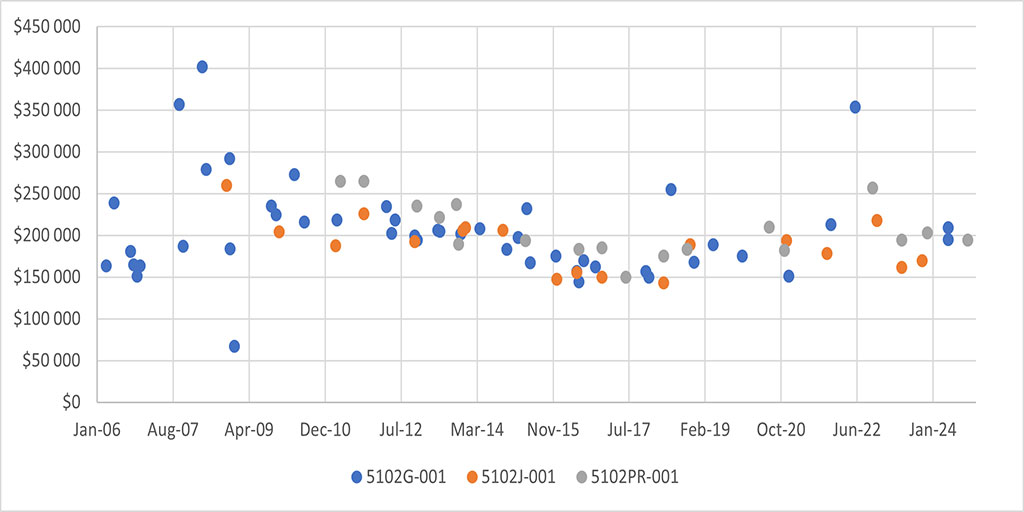
Special Orders
Ref. 5102T Titanium
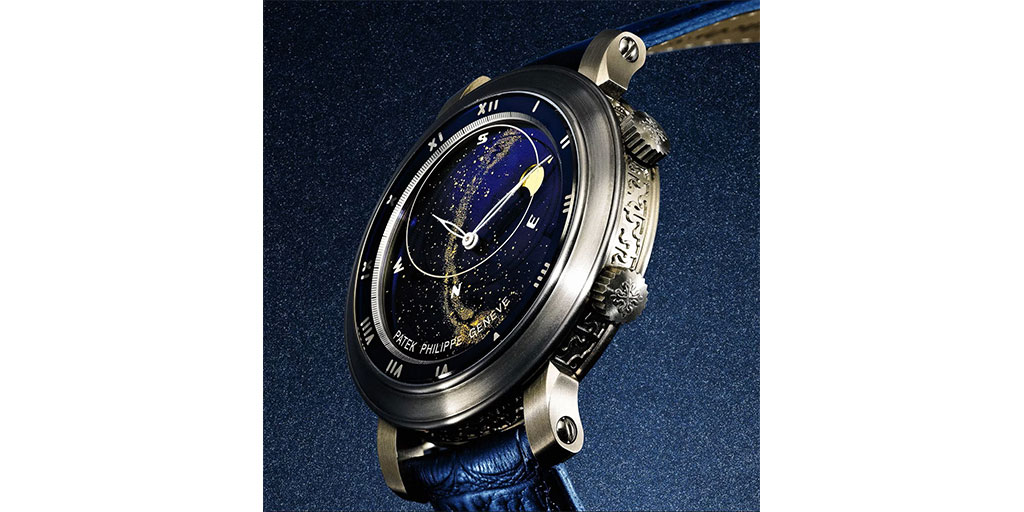
The same collector who commissioned the 5001T, also had an example of the ref. 5102 made in titanium in 2004 and it was offered during the same Sotheby’s sale in New York in June 2014. The case is made of titanium with matt finishing and is otherwise identical to the regular production model. It sold for $545,000 and remains the most expensive ref. 5102 sold.
Limited Edition Moscow
In 2007, as the regular white gold version was being replaced by the yellow gold, 50 pieces were produced for Mercury, the distributor of Patek Philippe in Russia. The pieces feature a celestial map as seen from Moscow (as opposed to Geneva) and are numbered xx/50. They are otherwise identical to the regular production model.
Prototype
A curiosity is the sale of a ref. 5102G with a prototype movement number “ET 839 N°3” sold for $529,200 by Sotheby’s New York in June 2022. The “ET” stands for “Etude Technique” (technical study) and the watch has never been commercialized. The auction listing describes a heist at the Musée de l’horlogerie et de l’émaillerie in Geneva in 2001 and states that “this Patek Philippe Reference 5102 is believed to have been among the stolen pieces” and the watch is “now freely able to be offered”.
The Ref. 6102 and Ref. 6103/6104 Celestial
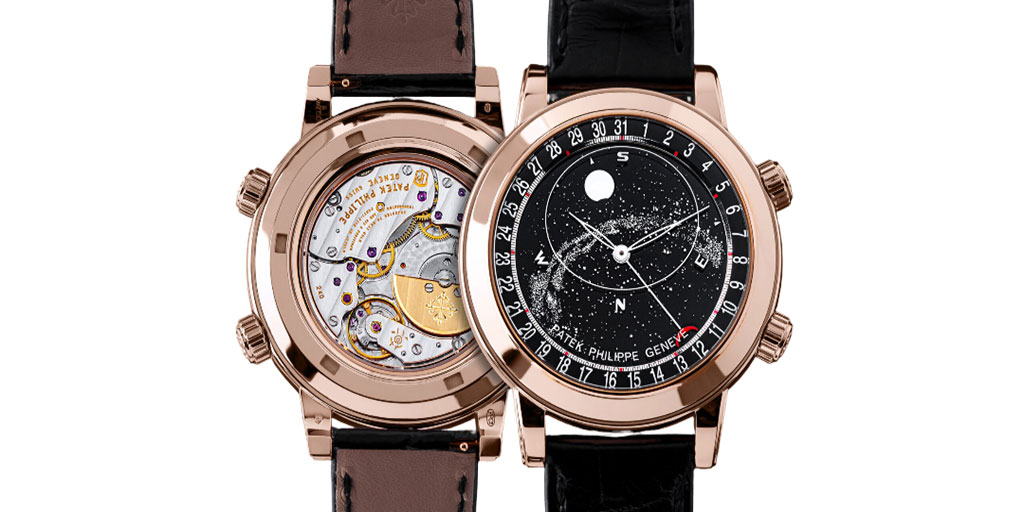
In 2012, Patek Philippe introduced the upgraded ref. 6102, with an added function compared to the ref. 5102. The slightly larger 44mm platinum case has a cleaner, sleeker appearance – in contrast to the ref. 6002, which has been richly decorated. The case bands no longer have the engraved Calatrava cross motif but are instead polished. The primary update was the addition of a date indicator around the outer rim of the dial. This addition made the watch more practical while maintaining its artistic appeal with the celestial sky chart, showing the apparent movement of stars and the moon phases.
At launch, the watch was available in platinum with a blue sky chart (ref. 6102P) and was followed by a rose gold and black sky chart model in 2015 (ref. 6102R), both versions being in the current catalogue.
The new case design allowed for high-end variants with gemstone-set bezels, which came in two versions.
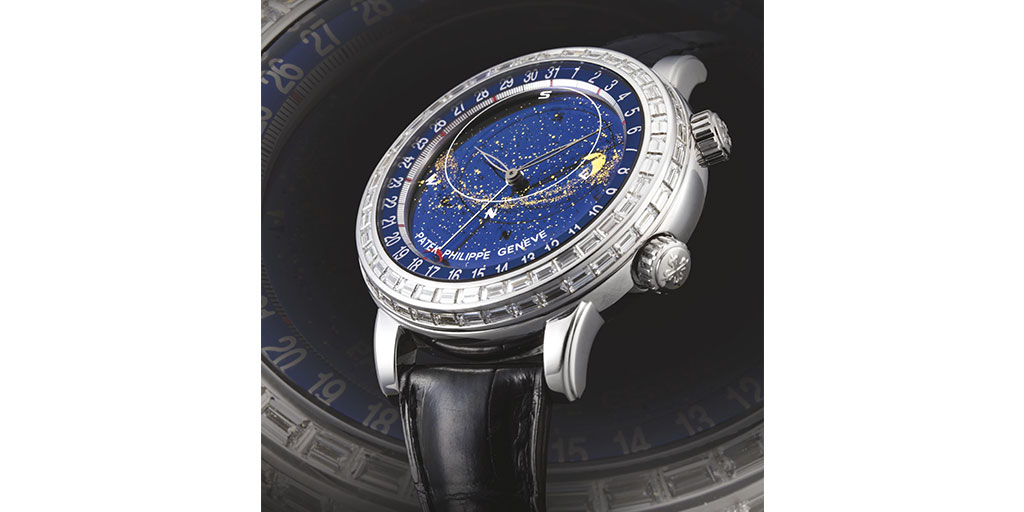
The first one was ref. 6103 with a double row on the top and side of the bezel of 76 baguette gemstones. It is known to exist in white gold with a blue dial (ref. 6103G-001) and rose gold with a black dial (ref. 6103R-010), both with diamonds (approximately 8 carats).
It was then replaced by ref. 6104 set with a single row of 38 baguette gemstones on top of the bezel (4.27 ct when set with diamonds). The following variations are known, the rose gold with a black dial, the white metals with blue dials:
- rose gold with diamonds (ref. 6104R-001)
- white gold with diamonds (ref. 6104G-001)
- white gold with diamonds and a white gold bracelet (ref. 6104/1G-001)
- platinum with diamonds (ref. 6104P-010)
- platinum with blue sapphires (ref. 6104/11P-010)
- platinum with rubies (ref. 6104/12P-010)
- platinum with emeralds (ref. 6104/13P-010)
While all of the gemstone-set variations are produced in very low numbers, the double-row-set ref. 6103 and the ref. 6104 set with sapphires, rubies, and emeralds are considered the rarest.
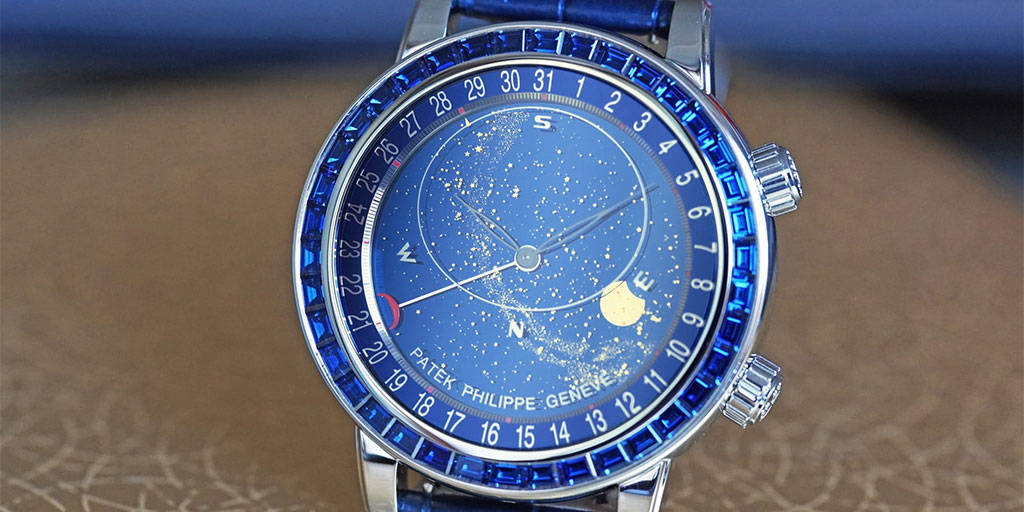
All these pieces have not appeared at auction frequently enough to permit meaningful analysis.
Conclusion
From Packard’s Warren, Ohio, sky a century ago to today’s gem-set masterpieces, Patek Philippe’s celestial watches represent horology’s highest aspiration: capturing infinity in miniature. These instruments marry astronomical precision with mechanical poetry, creating something no other complication can provide—a personal connection between the wearer and the cosmos.
Produced in extraordinarily limited numbers and appearing at auction only rarely, they remain watches worth chasing for the world’s most discerning collectors. Whether the baroque splendor of the ref. 6002’s hand-engraved arabesques, or the elegant simplicity of the ref. 5102, each celestial watch stands as singular achievement in the marriage of science, engineering, and art.
And perhaps somewhere, Henri Graves Jr.’s second sky chart pocket watch still exists, waiting to be rediscovered—one more mystery in the constellation of Patek Philippe’s celestial legacy.
October 2025
From the author: I dedicate this article to my father, who, while having little interest in watches, has always been a fond enthusiast of all things astronomy and provided great inspiration.
Edouard Henn has been passionate about horology since his teenage years. He began his professional journey at Girard-Perregaux in La Chaux-de-Fonds before transitioning to luxury retail across Europe and the Middle East. With a business education background, Edouard brings both product and collector’s perspective to his writing. Now based between Geneva and Paris, he enjoys sharing horological knowledge and connecting with fellow enthusiasts in the watch community.

